Mon., Apr. 23, 2007
The Experiment #4 report revisions were due today.
The Optional Assignment was due today. Answers to the optional
assignment were distributed in class.
Quiz #4 is Wednesday this week. Reviews are scheduled for Mon.
and Tue. afternoon. A copy of the Quiz #4 Study Guide will be
handed out in class. The Quiz #4 Study
Guide is also available online.
Lightning
is the topic today. Lighning is usually produced by thunderstorms.

A typical summer thunderstorm in Tucson. Remember that
even in the summer
a large part of the middle of the middle of the cloud is found at below
freezing temperatures and contains a mixture of super cooled water
droplets and ice crystals. This is where the ice crystal process
of precipitation formation operatures and is also where electrical
charge is created.
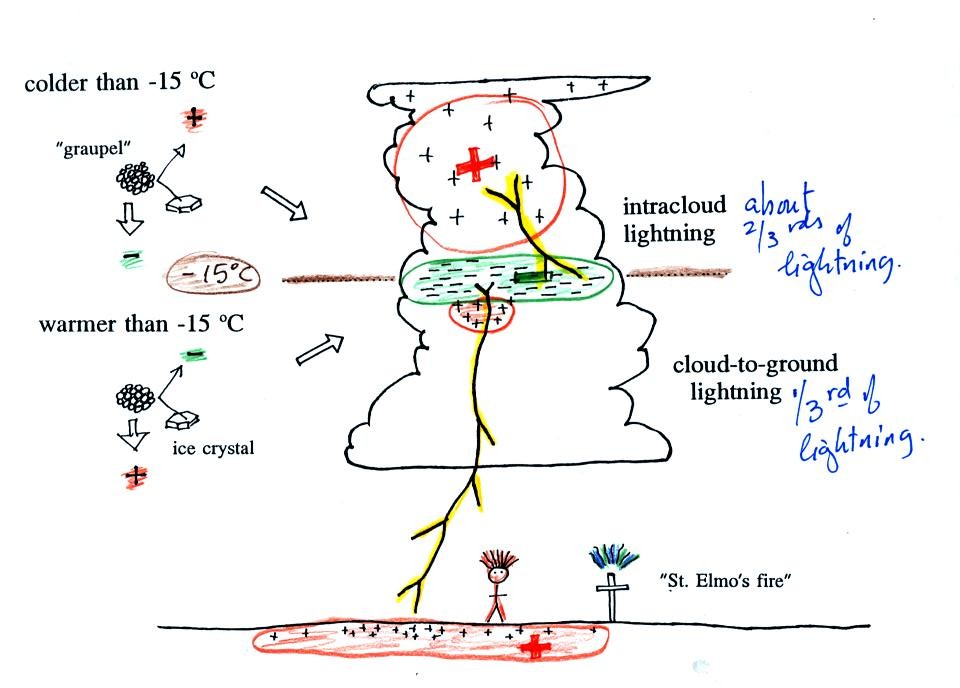
Collisions between precipitation particles produces the
electrical charge needed
for lightning.
When temperatures are below -15 C, graupel becomes negatively charged
after colliding with a snow crystal. The snow crystal is
positively charged and is carried up toward the top of the cloud by the
updraft winds. At temperature warmer than -15 (but still below
freezing), the charging is reversed. Large positive and negative
charge centers begin to build up inside the cloud. When the
electrical attrative forces between these charge centers gets
high enough lightning occurs.
Most
lightning (2/3) stays inside the cloud and travels between the main
positive
charge center near the top of the cloud and a large layer of negative
charge in the middle of the cloud; this is intracloud lightning.
About 1/3 of all lightning
flashes strike the ground. These are called cloud-to-ground
discharges.
A couple of interesting things that can happen at the ground when the
electrical forces get high enough. Attraction between positive
charge in the ground and the layer of negative charge in the cloud can
become strong enough that a person's hair will literally stand on end
(a dangerous situation to be in). St. Elmo's fire is a faint
electrical discharge that sometimes develops at the tops of elevated
objects during thundestorms.
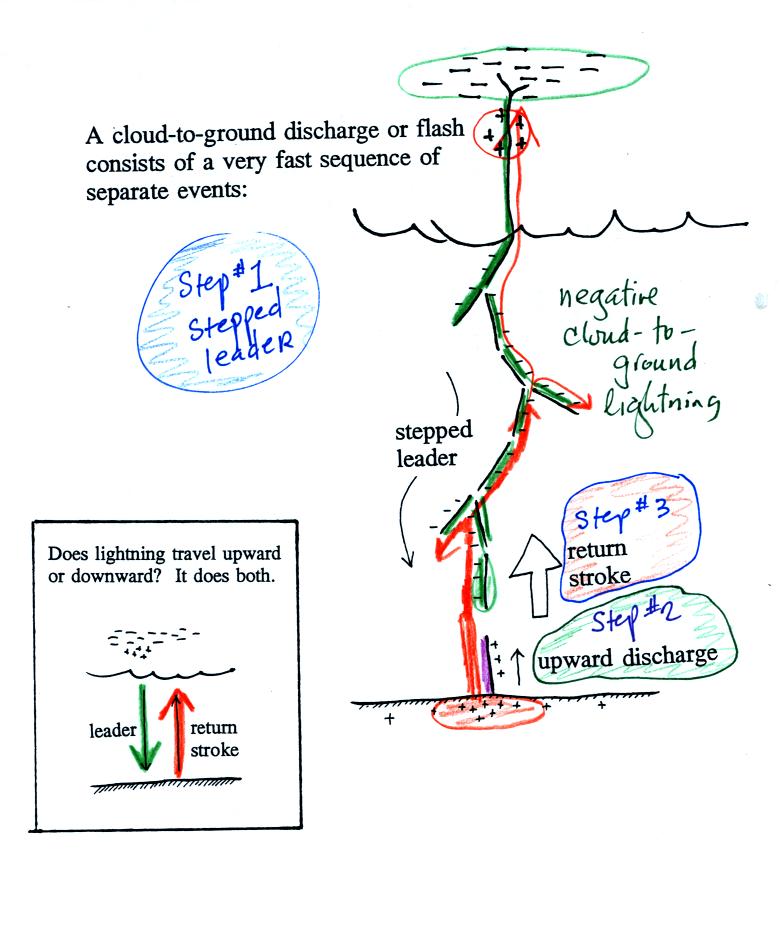
Most cloud to ground discharges begin with a negatively
charged
downward moving stepped leader. It makes its way down toward the
cloud in 50 m jumps that occur every 50 millionths of a second or
so. Every jump produces a short flash of light. An upward
discharge is initiated when the stepped leader nears the ground.
A powerful return stroke travels back up the channel (and out into all
the branches) once the upward discharge and the stepped leader
meet. These three steps are shown in additional detail below.

A sequence of stepped leader steps,
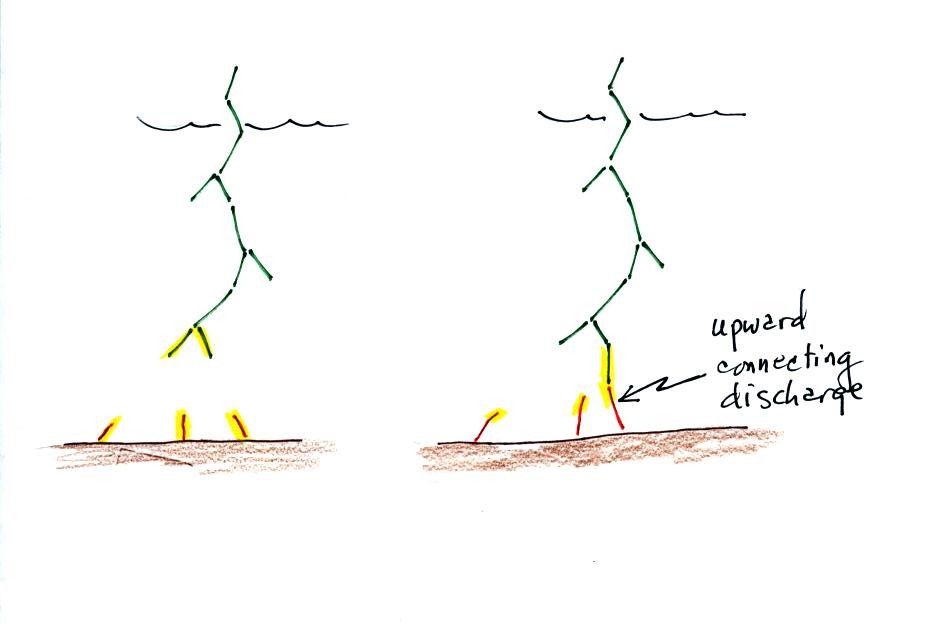
Several
positively charged upward discharges begin to travel upward from the
ground. One
of these will eventually intercept the stepped leader.
This
is what determines what will be struck by the lightning.
Lightning doesn't really know what it will strike until it gets close
to the ground. Lightning rods take advantage of this principle.
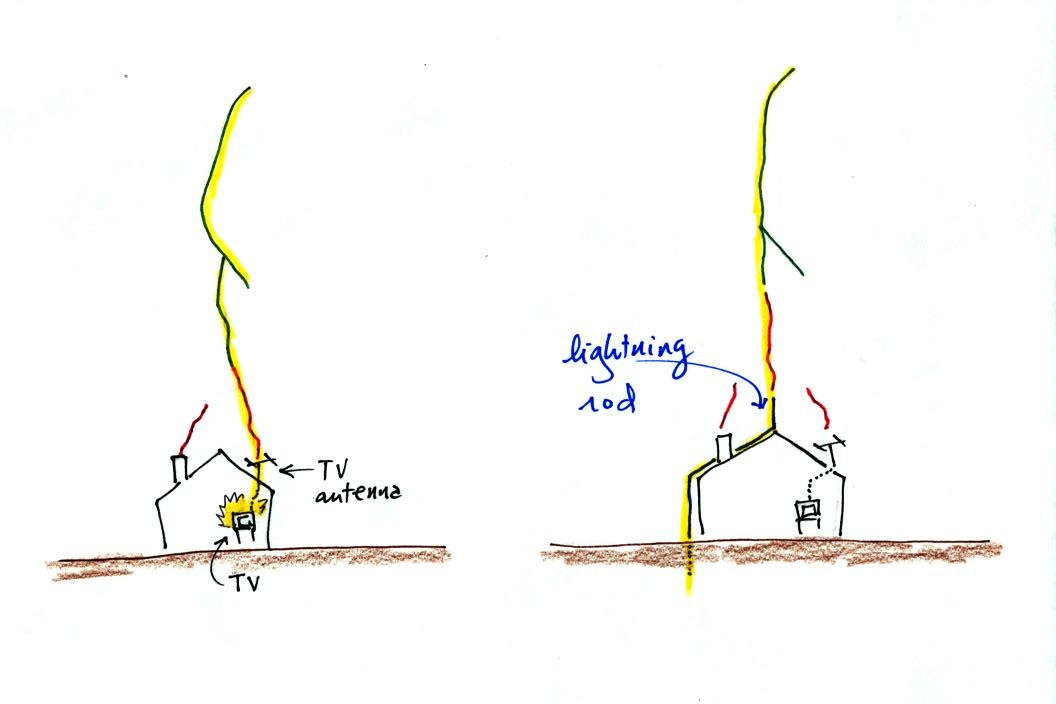
Houses with and without lightning rods are shown
above. When lightning strikes the house without a lightning rod
the powerful return stroke travels into the house destroying the TV and
possibly starting the house on fire.
A lightning rod is supposed to intercept the stepped leader and safely
carry the lightning current around the house and into the ground.
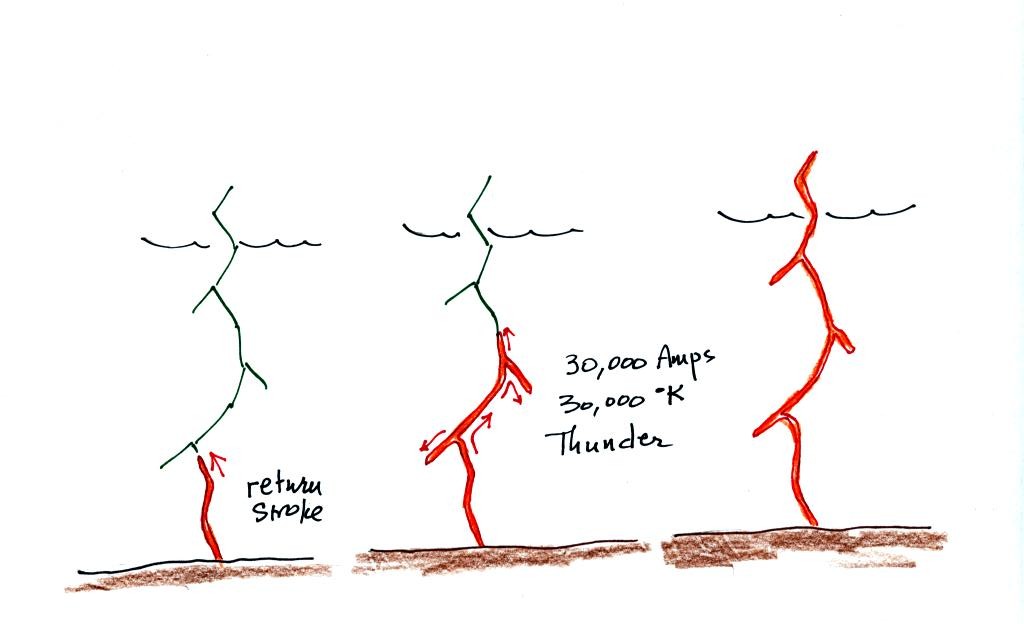
The
connection between the stepped leader and the upward discharge creates
a "short circuit" between the charge in the cloud and the charge in the
ground. A powerful current travels back up the channel from the
ground toward the cloud. This is the return stroke. Large
currents (typically 30,000 amps in the first return stroke) heat the
air to around 30,000K (5 times hotter than the
surface of the sun) which causes the air to explode. When you
hear thunder, you are hearing the sound produced by this explosion.
Stepped leader - upward connecting discharge - return stroke
animation
Many cloud-to-ground flashes end at this point.

In about 50% of cloud to ground discharges,
the stepped leader-upward
discharge-return stroke sequence repeats itself with a few subtle
differences. A downward dart leader travels from the cloud to the
ground. The dart leader doesn't step but travels smoothly and follows
the channel created by the stepped leader (avoiding the
branches). It is followed by a slightly less powerful subsequent
return stroke that travels back up the channel to the cloud.
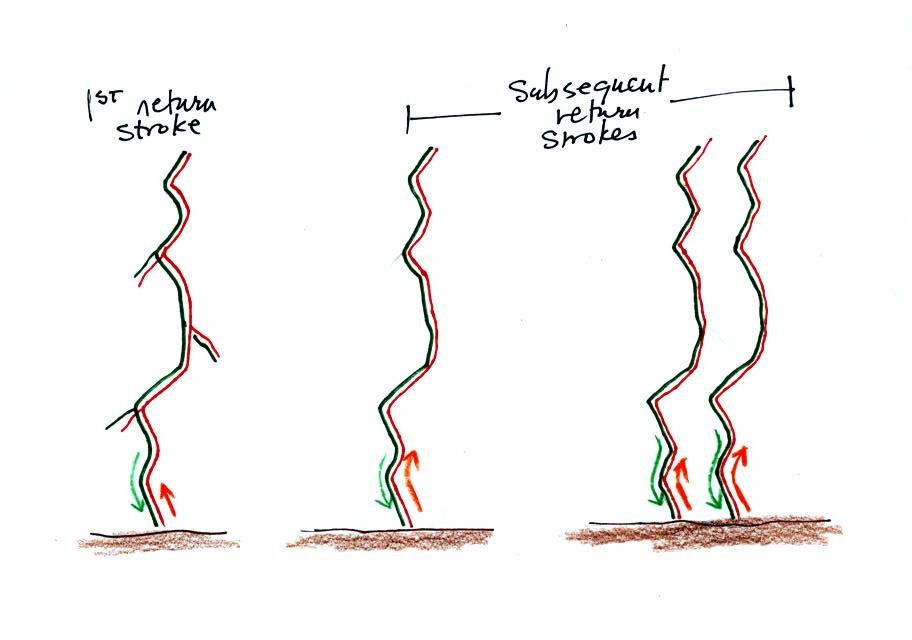
A normal still photograph would capture the separate
return strokes
superimposed on each other. If you bumped or moved the camera
during the photograph the separate return strokes would be spread out
on the image.
The image above shows a multiple stroke flash consisting of 4 separate
return strokes.
There is enough time between separate return strokes (around 1/10 th
second) that your eye can
separate the individual flashes of light.
When lightning appears
to flicker you are seeing the separate return strokes in a multiple
stroke flash. The whole flash usually lasts 0.5 to 1 second.
Here are
some unusual types of lightning.

Occasionally a lightning stroke will travel from the
positive charge
region in the top of the thunderstorm cloud to ground. These
types of strikes are more common at the ends of storms and in winter
storms. This is probably because the top part of the cloud gets
pushed sideways away from the middle and bottom portions of the
cloud. Positive strokes are very powerful. They sometimes
produce an unusually loud and long lasting clap of thunder.
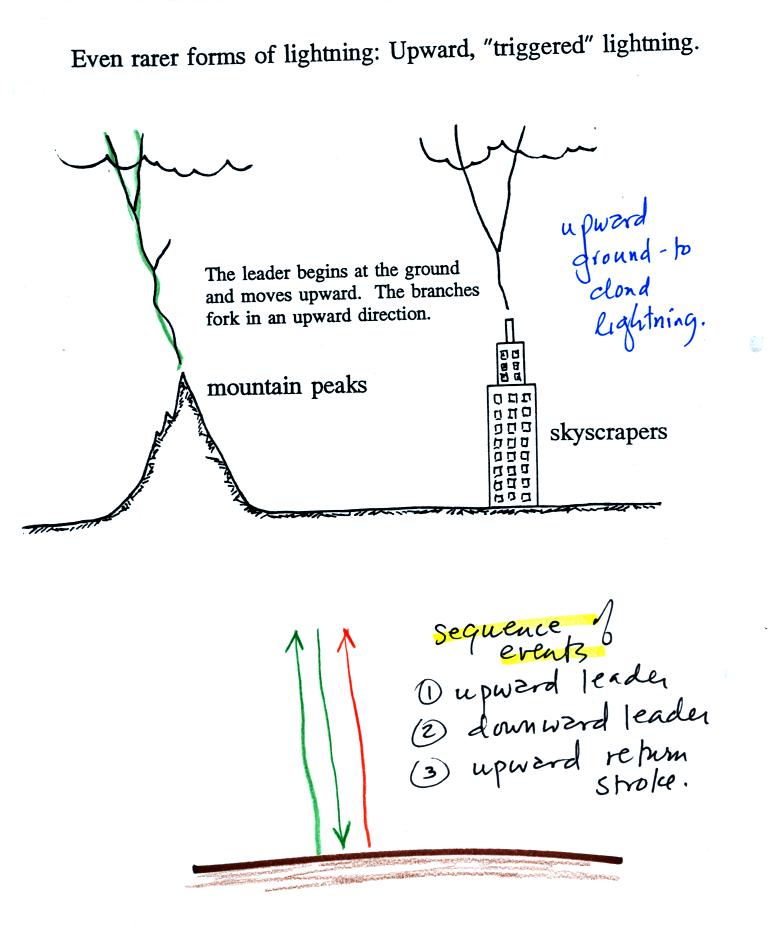
Lightning sometimes starts at the ground and travels
upward.
Upward lightning is generally only initiated by mountains and tall
objects such as a skyscraper or a tower of some kind. These
discharges are initiated by an upward leader. This is followed by
a more normal downward leader and an upward return stroke.
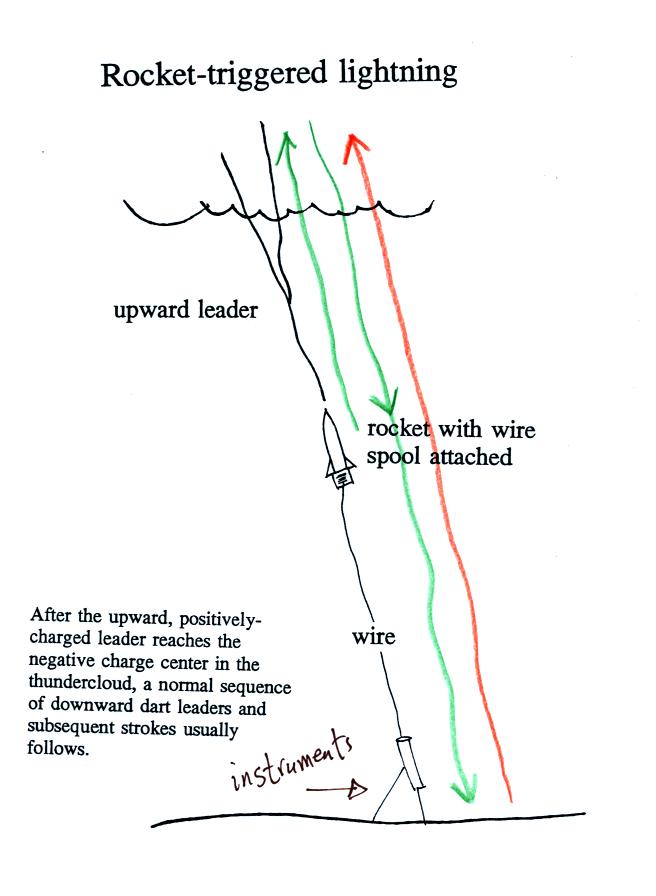
Scientists are able to trigger lightning by firing a small
rocket up
toward a thunderstorm. The rocket is connected by a thin wire to
the ground. When the rocket gets 50 to 100 m above the ground
upward lightning will develop off of the top of the wire.
Scientists are able to take closeup photographs and make measurements
of lightning currents using triggered lightning. Triggered
lightning can also be used to test the operation of lightning
protection devices. A short video showing rocket triggered
lightning experiments was shown in class.
Near the end of the tape you will some cases where the
lightning didn't
follow the wire all the way to the ground (this is one reason why you
need to be very careful doing experiments of this type). When the
lightning strikes the sandy soil (instead of striking instruments on
the ground) it sometimes will leave behind a fulgurite.


This is a drawing of a science fair project. If
10 to 20
Amps will cook a hotdog,
imagine what the 10,000 to 30,000 Amps in a lightning return stroke can
do. We wrapped up class with some lightning safety information.
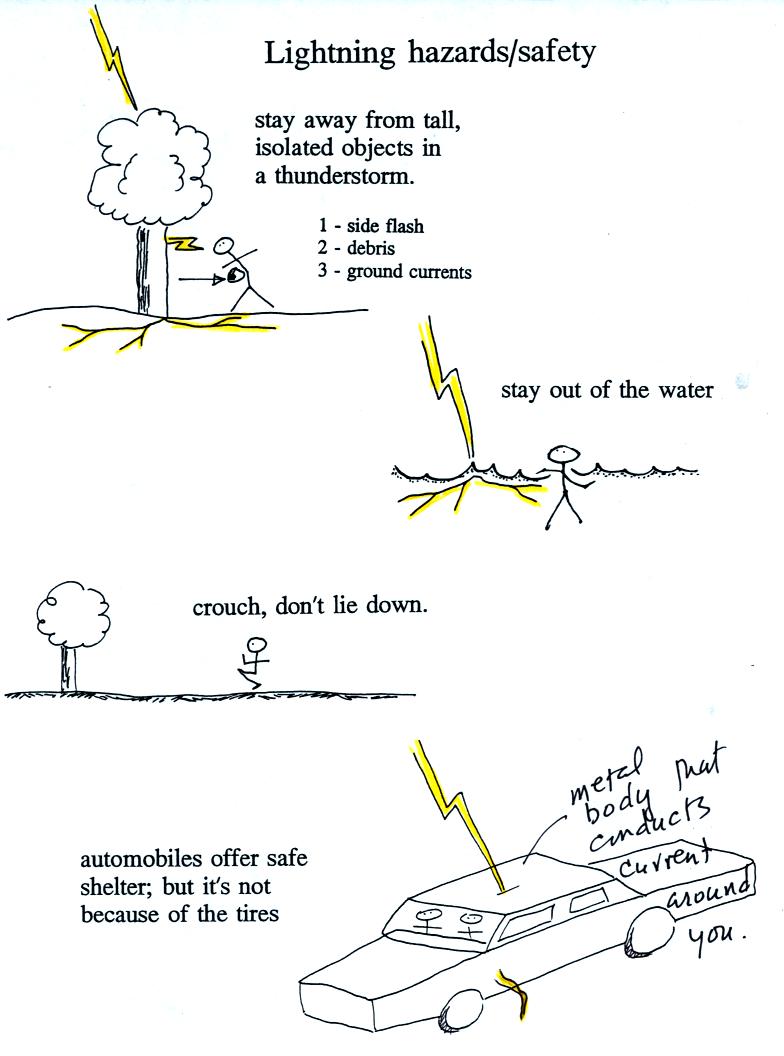
Stay away from tall isolated objects during a lightning
storm.
You can be hurt or killed just by being close to a lightning strike
even if you're
not struck directly.
An automobile with a metal roof and body provides good
protection from
lightning. The lightning current will travel through the metal
and around the passengers inside (the people in Florida that were
triggering lightning were inside a metal trailer and were perfectly
safe). The rubber tires really don't play any role at all.
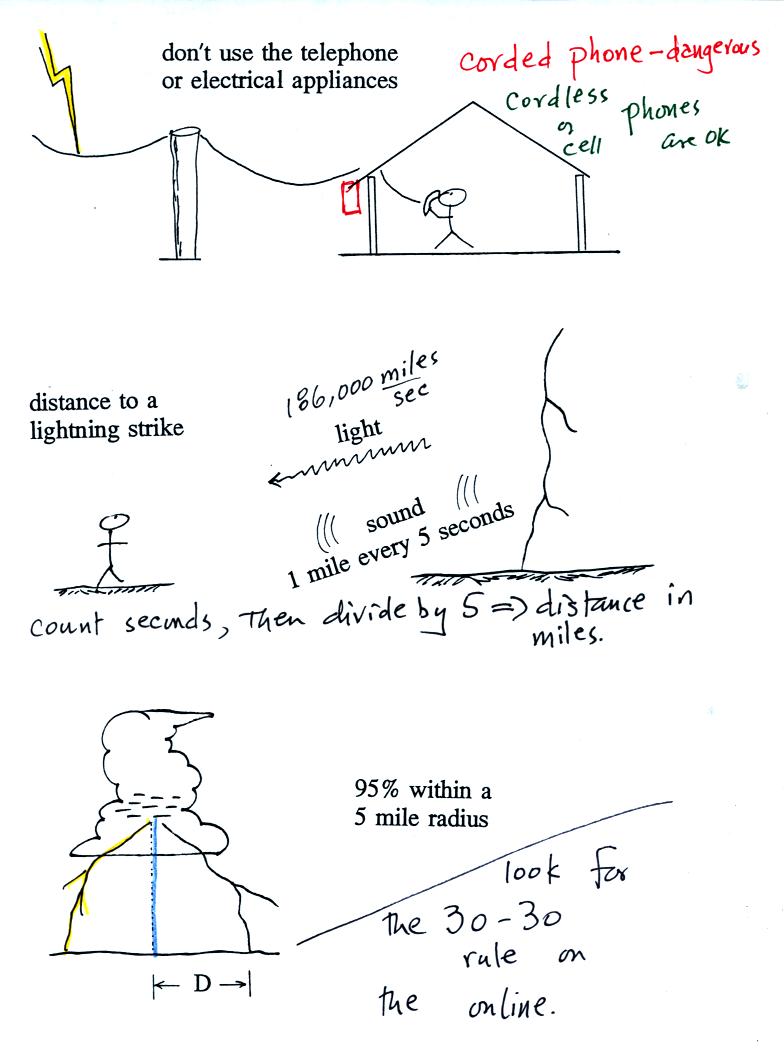
You shouldn't use a corded phone and electrical appliances
during a lightning storm because lightning currents can follow wires
into your home. Cordless phones and cell phones are safe.
To estimate the distance to a lightning strike
count the
number of
seconds between the flash of light and when you first hear the
thunder. Divide this by 5 to get the distance in miles.
The latest lightning safety recommendation is the 30/30 Rule. You
'll see that explained below.
The 30/30 rule
 Any
lightning safety plan should incorporate the 30/30 Rule. The 30/30 Rule
states that people should seek shelter if the "Flash-To-Bang" delay
(length of time in seconds between a lightning flash and its subsequent
thunder), is 30 seconds or less, and that they remain under cover until
30 minutes after the final clap of thunder.
Any
lightning safety plan should incorporate the 30/30 Rule. The 30/30 Rule
states that people should seek shelter if the "Flash-To-Bang" delay
(length of time in seconds between a lightning flash and its subsequent
thunder), is 30 seconds or less, and that they remain under cover until
30 minutes after the final clap of thunder.
A 30 second lead time is necessary prior to a storm's arrival because
of the possibility of distant strikes. A 30 minute wait after the last
thunder is heard is necessary because the trailing storm clouds still
carry a lingering charge. This charge can and does occasionally produce
lightning on the back edge of a storm, several minutes after the rain
has ended.
Studies have shown most people struck by lightning are struck not at
the height of a thunderstorm, but before and after the storm has
peaked. This shows many people are unaware of how far lightning can
strike from its parent thunderstorm. DO NOT wait for the rain to start
before seeking shelter, and do not leave shelter just because the rain
has ended.
(from
Jetstream An Online School for Weather )
















 Any
lightning safety plan should incorporate the 30/30 Rule. The 30/30 Rule
states that people should seek shelter if the "Flash-To-Bang" delay
(length of time in seconds between a lightning flash and its subsequent
thunder), is 30 seconds or less, and that they remain under cover until
30 minutes after the final clap of thunder.
Any
lightning safety plan should incorporate the 30/30 Rule. The 30/30 Rule
states that people should seek shelter if the "Flash-To-Bang" delay
(length of time in seconds between a lightning flash and its subsequent
thunder), is 30 seconds or less, and that they remain under cover until
30 minutes after the final clap of thunder.